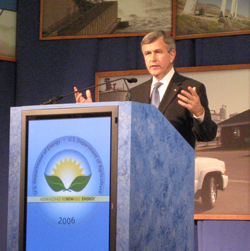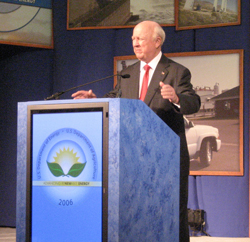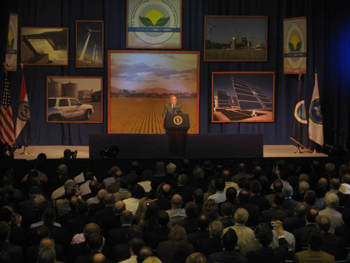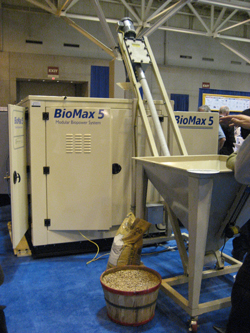 The US Secretaries of Agriculture and Energy are the hosts of the Advancing Renewable Energy Conference in St. Louis this week. Both addressed the crowd, estimated at upwards of 1500 people, showing the huge interest in renewable energy nationwide.
The US Secretaries of Agriculture and Energy are the hosts of the Advancing Renewable Energy Conference in St. Louis this week. Both addressed the crowd, estimated at upwards of 1500 people, showing the huge interest in renewable energy nationwide.
Both Secretaries talked about the great need for cellulosic ethanol – in fact, just about every speaker today has at least touched on the topic. Secretary Johanns had the pleasure of announcing $17.5 million dollars in biofuels research and development grants, funded jointly by USDA and DOE. “Developing renewable energy is a priority for the Bush administration,” said Johanns. The 17 projects to be funded by this grant money include projects such as development of commercial corn hybrids for cellulosic biomass to ethanol, willow biomass crop management, waste biomass feedstocks for ethanol production, and doubling switchgrass yield by 2020 for cellulosic ethanol.
Johanns took on a few of the arguments of the (mostly ethanol) “naysayers,” starting with the claim that ethanol costs too much to be competitive with oil without subsidies.
“It costs about $1.10 to produce a gallon of ethanol,” said Johanns. “In fact, ethanol will continue to be competitive with gasoline as long as oil prices don’t drop below $30 per barrel.”
Regarding whether we can produce enough corn to meet the demand, Johanns said people who say that, “haven’t met the same farmers I have.” Johanns added that USDA economists estimate that ethanol production “could nearly double in the next five years, without forcing us to choose between corn for food or for fuel,” and he added that research into new varieties, biomass and new technology will make that happen.
Secretary Bodman noted some of the exciting research the Department of Energy is doing in rapid DNA sequencing and advanced light sources which are making “energy from biomass more promising than any time before.”
Bodman says the goal of the administration is to make cellulosic ethanol cost-competitive by 2012, but that their efforts “are not confined exclusively to cellulosic ethanol. We are also sponsoring promising research on other biofuels from biomass, inlcuding bidiesel, biofuels for aviation, and biologically produced or inspired hydrogen and other fuels from sunlight.”
Listen to a segment of Johanns’ remarks here:  Johanns (5 min MP3)
Johanns (5 min MP3)
Listen to a segment of Bodman’s remarks here:  Bodman (3 min MP3)
Bodman (3 min MP3)
Coverage of the Advancing Renewable Energy Conference sponsored by the Ethanol Promotion and Information Council.
 President Bush got a nice round of applause when he just said, “I like the idea of promoting a fuel that relies upon our farmers.”
President Bush got a nice round of applause when he just said, “I like the idea of promoting a fuel that relies upon our farmers.” 

 We just received word that the president is on his way to the convention center from the airport, so everyone is taking a quick seventh-inning stretch before they are locked up. The media has a nice mid-row seat, check-in was smooth and easy, now we are just waiting for the main event.
We just received word that the president is on his way to the convention center from the airport, so everyone is taking a quick seventh-inning stretch before they are locked up. The media has a nice mid-row seat, check-in was smooth and easy, now we are just waiting for the main event.  Everybody who is anybody in the ethanol industry are in attendance here at the Advancing Renewable Energy Conference in St. Louis. Here is Greg Krissek, (left) Director of Governmental Affairs with
Everybody who is anybody in the ethanol industry are in attendance here at the Advancing Renewable Energy Conference in St. Louis. Here is Greg Krissek, (left) Director of Governmental Affairs with 

 Security has been really tight here for the Renewable Energy Conference, especially for speakers and media. They won’t let anyone through this restricted area unless they have a media badge and only staff are permitted to escort any other attendees to the media room for interviews. There were about 100 media registered for the conference itself, and several more local and national reporters are coming in today just for the president. This has gotten amazing coverage.
Security has been really tight here for the Renewable Energy Conference, especially for speakers and media. They won’t let anyone through this restricted area unless they have a media badge and only staff are permitted to escort any other attendees to the media room for interviews. There were about 100 media registered for the conference itself, and several more local and national reporters are coming in today just for the president. This has gotten amazing coverage.  The line was long to go through security at the Advancing Renewable Energy Conference in St. Louis. President Bush is scheduled to address the crowd of more than 1500 about lunchtime. We have been informed that we will all be in “lock down” here at the convention center between 11:00 am and 1:30 pm – no one in or out.
The line was long to go through security at the Advancing Renewable Energy Conference in St. Louis. President Bush is scheduled to address the crowd of more than 1500 about lunchtime. We have been informed that we will all be in “lock down” here at the convention center between 11:00 am and 1:30 pm – no one in or out.  Agriculture Secretary Mike Johanns did a little walk through of the trade show at the Advancing Renewable Energy Conference in St. Louis on Wednesday and stopped in front of the Ethanol Promotion and Information Council display with the Indy Car show vehicle.
Agriculture Secretary Mike Johanns did a little walk through of the trade show at the Advancing Renewable Energy Conference in St. Louis on Wednesday and stopped in front of the Ethanol Promotion and Information Council display with the Indy Car show vehicle.  Agriculture Secretary Mike Johanns mentioned this mighty machine in his remarks to the Advancing Renewable Energy Conference on Wednesday.
Agriculture Secretary Mike Johanns mentioned this mighty machine in his remarks to the Advancing Renewable Energy Conference on Wednesday.  The president of the
The president of the  Despite the government’s best efforts to be all-inclusive with the Advancing Renewable Energy Conference, it’s all too obvious that liquid fuels are the main attraction. That was evidenced by the attendance at the afternoon break-out sessions – one on heat and electricity and one on liquid fuels. The liquid fuels session was SRO, probably around 600-700 people, if not more. I’m not good at judging that stuff – I just know it was full – and they were actually scanning our name badges at the doors to get an accurate count, so I should know that at some point.
Despite the government’s best efforts to be all-inclusive with the Advancing Renewable Energy Conference, it’s all too obvious that liquid fuels are the main attraction. That was evidenced by the attendance at the afternoon break-out sessions – one on heat and electricity and one on liquid fuels. The liquid fuels session was SRO, probably around 600-700 people, if not more. I’m not good at judging that stuff – I just know it was full – and they were actually scanning our name badges at the doors to get an accurate count, so I should know that at some point. 
 The US Secretaries of Agriculture and Energy are the hosts of the Advancing Renewable Energy Conference in St. Louis this week. Both addressed the crowd, estimated at upwards of 1500 people, showing the huge interest in renewable energy nationwide.
The US Secretaries of Agriculture and Energy are the hosts of the Advancing Renewable Energy Conference in St. Louis this week. Both addressed the crowd, estimated at upwards of 1500 people, showing the huge interest in renewable energy nationwide. 